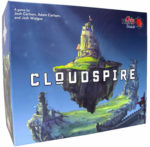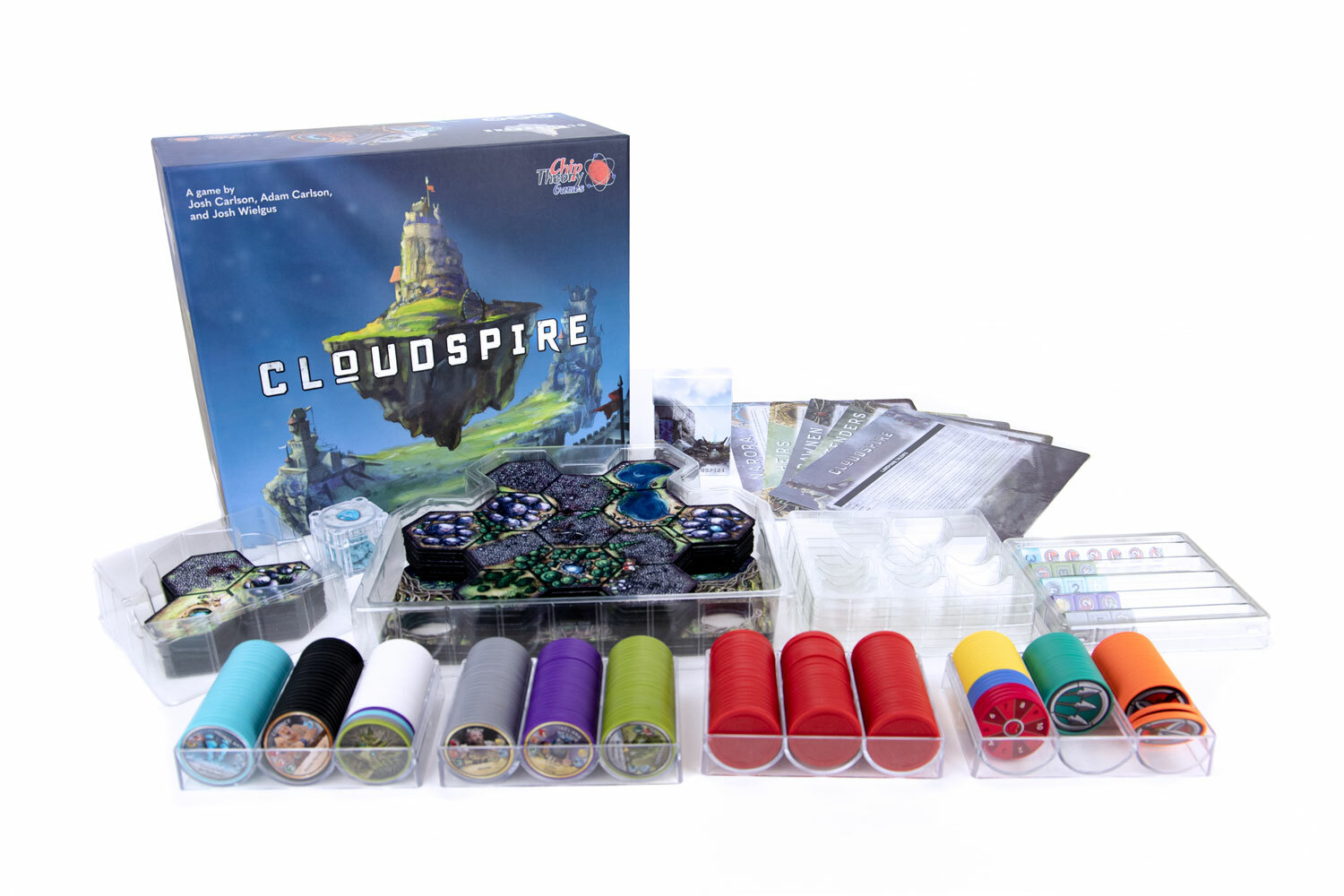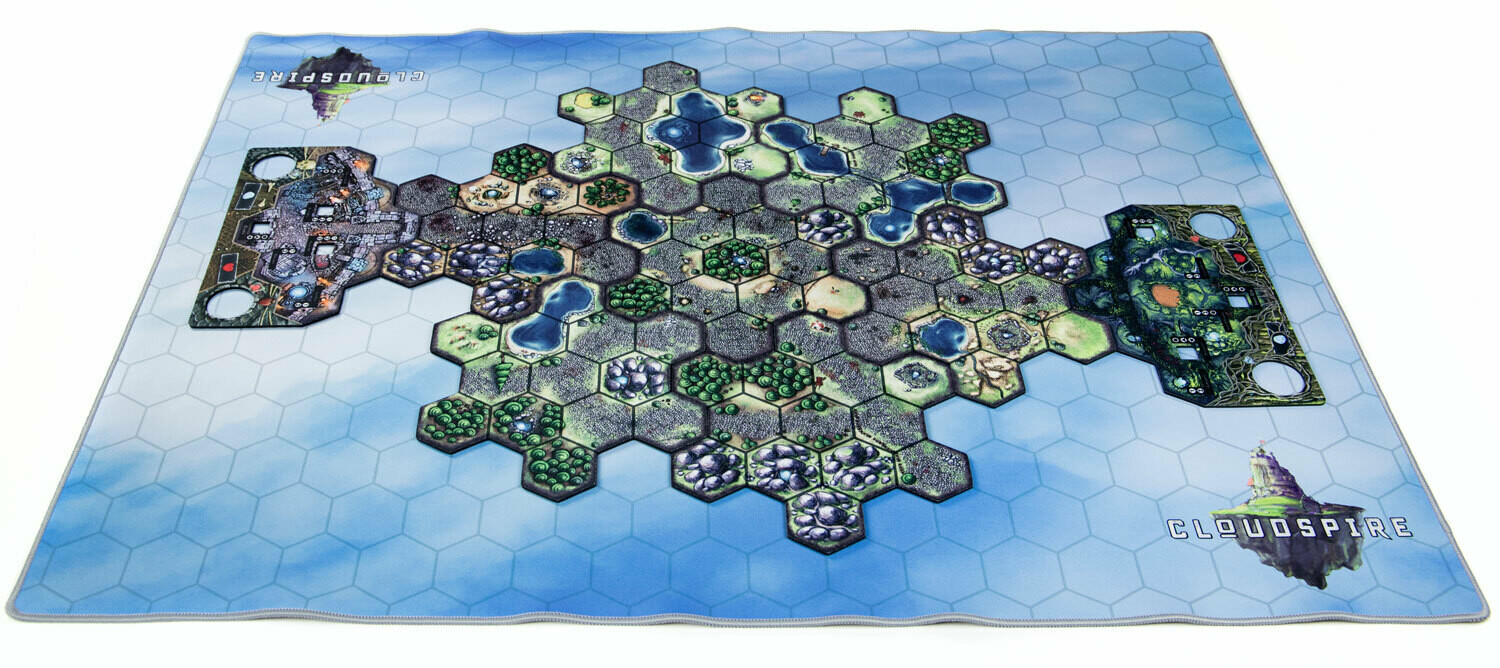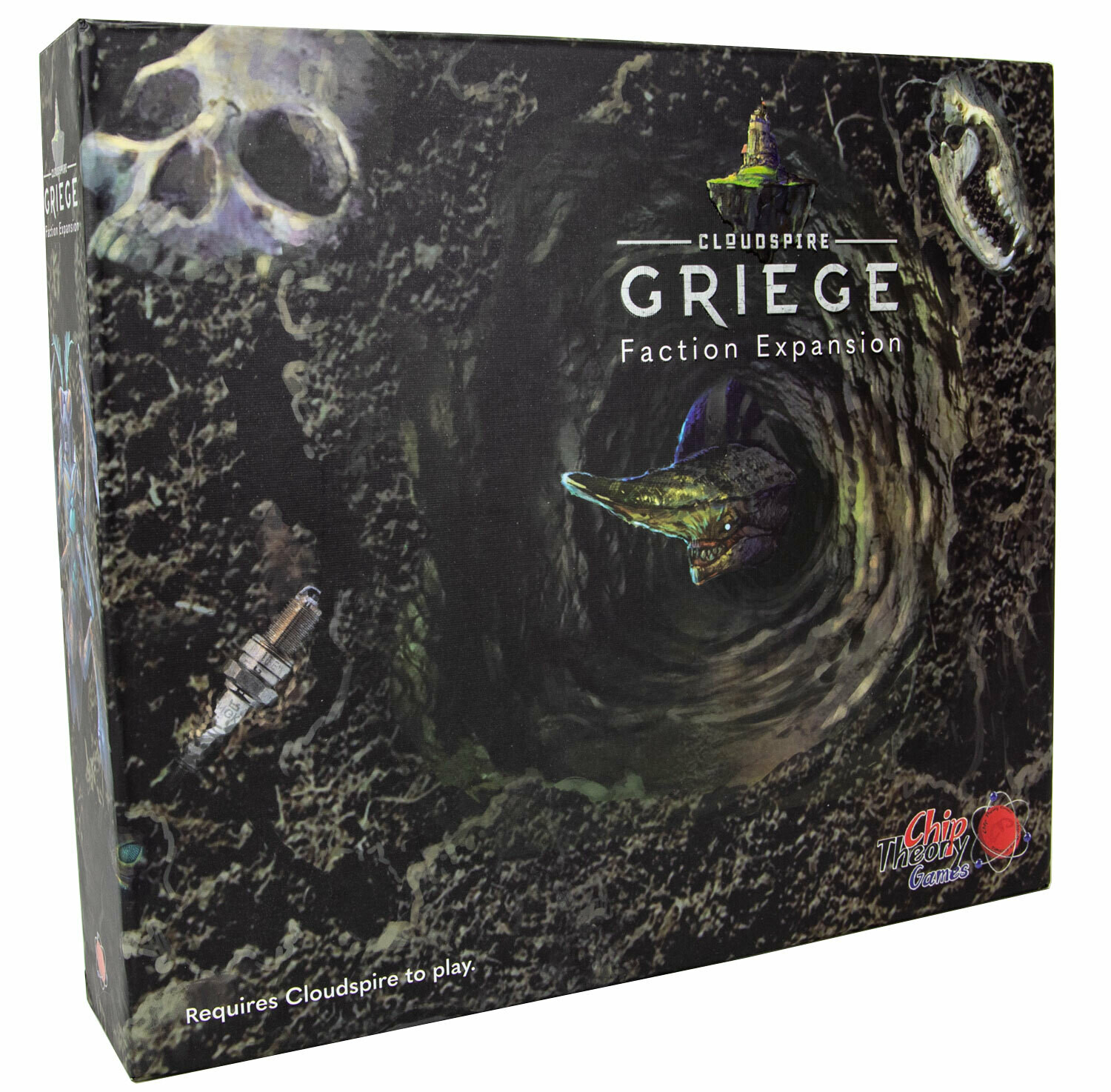Cloudspire (Boardgame)
 Cloudspire is a boardgame based around the extremely popular MOBA and tower defense genres of videogames. MOBAs have players working as a team of individual characters trying to destroy an enemy base, while fighting the other team and its stream of AI controlled “minions” streaming out of the opponent’s base. In Cloudspire, players send out heroes (which they control) and minions (which are sent out and just march along) against the other player (or players) in an attempt to wear down and destroy the opponent’s home base. Cloudspire provides plenty of gameplay in one package, with diverse starting factions (each with unique play styles) and many options of play (such as both solo, cooperative, and competitive modes.)
Cloudspire is a boardgame based around the extremely popular MOBA and tower defense genres of videogames. MOBAs have players working as a team of individual characters trying to destroy an enemy base, while fighting the other team and its stream of AI controlled “minions” streaming out of the opponent’s base. In Cloudspire, players send out heroes (which they control) and minions (which are sent out and just march along) against the other player (or players) in an attempt to wear down and destroy the opponent’s home base. Cloudspire provides plenty of gameplay in one package, with diverse starting factions (each with unique play styles) and many options of play (such as both solo, cooperative, and competitive modes.)
Cloudspire
Designer: Josh J. Carlson, Adam Carlson, Josh Wielgus
Publisher: Chip Theory Games
Players:1-4
Ages: 13+
Time: 90-180min
(review copy provided by publisher)
At first glance, MOBA games like League of Legends, DOTA 2, or Heroes of the Storm do not seem like likely candidates for a boardgame. However, as they feature team vs team play, it offers a unique opportunity to provide a boardgame with options for individual, team, and cooperative play. A game like League of Legends (LoL) has two opposing sides. Each side’s base generates waves of little minions that then happily march across the screen along a set path, attacking anything that gets in their way. Meanwhile the players each control a hero that can roam at will and attack the opposing minions or players on the other team. In addition, sides have defensive towers strewn along the path which attack and kill the minions, but can eventually be overwhelmed. The heart of the game lies in a player’s control of their hero. As they attack minions (and each other) they grow more innately powerful and collect resources which can be used to buy new equipment. Eventually, one side’s minions and heros are able to push into the enemy base and destroy it for the win. It is a very fun and compelling game as it rewards skill, tactics, and planning. Each hero (out of many) is unique and can be modified even further with additional equipment.

Contents displaying the poker chips used to represent units and spires.
Cloudspire takes this formula and translates it into the boardgame world. The game consists of 2 to 4 players (teams or free for all) who manage their home faction (and all of its unique abilities and upgrades) along with a unique set of 3 heroes and an assortment of minions and defensive towers. Over the course of four rounds, players spend resources to place minions, heroes, and defensive towers and set them loose to attack an opposing player’s home base. Defeat your opponents’ home base to win the game. There are two main currencies in the game. “Source” is primarily gained from defeating opponents’ pieces (heroes, minions, or towers) and most factions also have a secondary way to obtain it (either on the board or via upgrades.) Source is used to purchase upgrades, build towers, and buy (heroes, towers, or items) from the common store. This carries over from round to round and finding ways to obtain and spend one’s source wisely is important for success. Players also gain an increasing source “income” at the start of each round. The second resource is Command Points (CP.) These are provided at the start of each round and increase in each succeeding round. For the most part, players are not able to increase their CP income, nor are they able to save them for later. Command Points are the limiting factor for a player to add new units to the board. Players can spend them on new minions for the wave, or another hero (to a maximum of 2 on the board at one time.) In this way, CP is a resource that remains balanced throughout the game.
Once players choose their upgrades and purchase their units, they are placed onto the map. Almost everything in the game is represented by nice, hefty poker chips. A unit (minion or hero) would typically display its health and attack values on the face of the chip. When placing it on the board, a matching number of health chips are placed underneath. Spires (defensive towers) are built over specific “source” hexes on the map and have attack, range, and/or defense chips placed underneath. As units or spires are attacked, they lose the appropriate number of chips and are eliminated if they have no chips left. At the start of a wave (one of the four) all of a player’s minions and heroes (those not still out from previous rounds) are placed into a giant “stack.” Minions can also be grouped, such that they move as a group. The group has the abilities of the top minion, but the bottom units are “protected” until the top minion is defeated.

The board layout (on an optional special playmat.)
Once the round begins, players take turns moving all their units. Minion units travel along the shortest path to their target opponent, with the closest minions moving first. Heroes are more flexible, able to move wherever their owner wants (barring any terrain restrictions) and can move before or after the minions. Once everything is moved, any opponent-owned towers fire at a unit within range, and then all minions must attack if they can, while heroes have the options. If an attack does not kill an opponent, it gets to strike back for damage. (Spires do not strike back.) Players continue taking turns until all the minion units are eliminated (heroes still alive get to stay on the board.) Players then gain more Source and spend it on upgrades, towers and purchases. Command Points are then spent on new minions (and heroes) and the next wave commences. After four waves, if there are still players with standing bases, the base with the most health left is the winner, with ties going to the most upgraded base.
Verdict:
This is not a small, short, nor simple game. Learning the game from the rules alone is a bit of a chore (some online overview videos help immensely) and we made a few key mistakes in our first game (one of which was actually played as written but fixed in an errata/FAQ.) ISetup, however, is not too bad as one just slaps down the board tiles and distributes to each player their forces. Thanks to a well-designed insert and containers, all the pieces are easy to store and access. Once the general play of the game is understood, players need to figure out how to effectively play their particular faction. This means there’s probably a game’s learning cure for how to play the game, as well as something like an additional game learning how to play each faction. Each faction (there are 4 in the box and 1 in an expansion) has their own base upgrades, towers, units, and heros – most with thematic powers associated with that side. This has upsides and downsides. The downside is an additional learning curve for each faction, but the upside is the variety of options and replay value contained in each faction. There are multiple viable strategies for each side. My first play had me going after some source-generation options along with the use of very powerful, but chaotic (sometimes they didn’t move or attack in a turn) minions.
As one can see just by looking at the large & imposing box full of bits, there is a lot of game here. Gamers looking for a big game with an overarching plot and lots of long-term strategic options will find Cloudspire to their liking. One feature that attracts me to the game the most are the options for solo and cooperative play. While my eldest and I can take each other on in a two player vs-mode, having the options for a cooperative game is great as it gives us that father-son team feeling. The included solo and co-op scenario booklet tries to tell a story arc over the course of a series of solo and co-op games. These are preset games, requiring specific player and enemy factions along with a particular game setup. Players can’t just each pick a side, pick an enemy, and then go for it. However, there are scenarios for most faction setups, and each of those should be good for a couple games while players try out different strategies.
Is Cloudspire for you? It isn’t a traditional “european-style” boardgame, and lies more in the wargame “dudes on a map” style game. It does a pretty good job of simulating that MOBA style of game, so fans of that genre (willing to play a game with this many moving parts) should find plenty to like. It is lengthy, but short enough to fit a single game into an evening’s play. I’m a fan of asymmetric gameplay, and Cloudspire has this in spades. If you don’t mind a bit of complexity, but love having options that play differently than any of the other players in the game, I strongly recommend it.

The Griege expansion, featuring more darker-themed units and heroes.
Kid Factor
There is a lot going on here. Once taught, the basic rules aren’t too bad to figure out, thanks to the well-designed pieces and parts that help to clearly indicate the situation on the board. However, each faction has half a dozen or so unique upgrades each with new rules and options, so it takes a bit of effort to keep all of that straight. I would say reading (well) is a must. I’d play with a tween, but only with one who has a fair bit of gaming experience. I’d wait until at least early teens before trying to teach it to someone who hasn’t played a lot of games of this type before. All that said, there’s not much to worry about thematically. “Death” is relatively bloodless, the art seemed to avoid gratuitous lack of clothing (something that can happen in the fantasy trope.) The only possible concern one might have is with some of the “darker” themed factions which have the standard undead/skeleton/zombie thing going on.)





Discussion Area - Leave a Comment